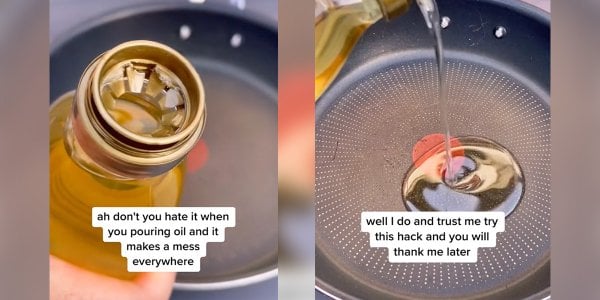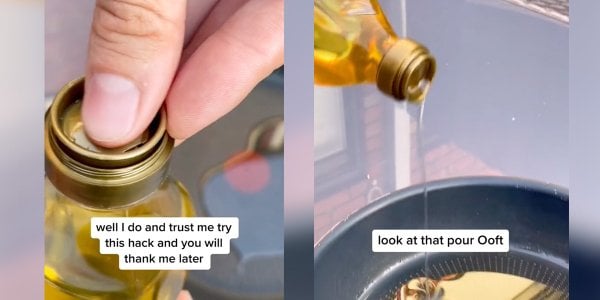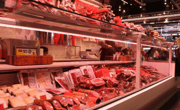Unbelievable video reveals the true purpose of the plastic pull tab on your cooking oil
By
VanessaC
- Replies 6
We love coming across things and tips online that make everyday tasks a little bit easier.
In this story, we’ll zoom in on a simple yet annoying cooking scenario: pouring cooking oil.
Isn’t it annoying how sometimes, the way it comes out of the bottle ends up a bit messy, with more than a few splashes here and there in your cooking area?
Well, this little trick recently shared by two friends named Zach and Steve which may spare you from that mess that comes with cooking and help you avoid any wastage!
Here’s the trick: Instead of throwing away the plastic pull tabs that come on your cooking oil bottles, as most of us do, they've revealed that the tab actually serves a notable purpose!
In a short video they shared on social media, they showed everyone that the pull tab can be pulled off, flipped over, and pushed back into the bottle.
That way, when you pour the oil on a pan, it helps control the amount that gets released from the bottle.
'Don’t you hate it when you‘re pouring oil and it makes a mess?' Zach asked.
'Well I do and, trust me, try this hack and you will thank me later. Stop throwing out the seal from your oil bottle, instead put it inside the top to control the pour.'
You won’t even need to flick at the bottle with your finger like you normally do to ensure you don't pour too much; just push the plastic tab in and it'll take care of everything for you.
The video has already been viewed more than 11,000 times, with many people writing in the comments that they had no idea the little plastic tab was used for something like this.
‘Can’t believe I did not know this,’ one commented.
Another said: ‘Wait… what? Brilliant!’
While a third wrote: ‘This is genius!’
“I’ve lived my whole life not knowing this...”, a fourth added.
You can watch the Zach demonstrating the trick below:
But it doesn't stop there! The same duo also shared a video earlier this year about the 'right' way to use a colander which got 3 million views.
A colander is commonly used to rinse vegetables or strain foods such as pasta by pouring them into the colander and allowing the water to seep through its holes.
‘You’ve been using a colander wrong,’ they captioned the video.
The trick is to pop the colander over the pot (with the bottom side facing down, forming a concave seal over the pot), holding all four of its handles together tightly, and tipping the pot. Voila! You have perfectly drained, well-contained pasta ready to be served.
‘For years I've been using the pot's lid to strain pasta,’ one viewer commented.
While another added: ‘I have not been using it wrong. You are just using it a different way.’
‘I’m going to start doing this because I hate having pasta everywhere,’ a third added.
You can watch their method of using a colander below:

If you have unknown (or maybe lesser-known!) tips for cooking, share them with us in the comments below!
In this story, we’ll zoom in on a simple yet annoying cooking scenario: pouring cooking oil.
Isn’t it annoying how sometimes, the way it comes out of the bottle ends up a bit messy, with more than a few splashes here and there in your cooking area?
Well, this little trick recently shared by two friends named Zach and Steve which may spare you from that mess that comes with cooking and help you avoid any wastage!
Here’s the trick: Instead of throwing away the plastic pull tabs that come on your cooking oil bottles, as most of us do, they've revealed that the tab actually serves a notable purpose!
In a short video they shared on social media, they showed everyone that the pull tab can be pulled off, flipped over, and pushed back into the bottle.
That way, when you pour the oil on a pan, it helps control the amount that gets released from the bottle.
'Don’t you hate it when you‘re pouring oil and it makes a mess?' Zach asked.
'Well I do and, trust me, try this hack and you will thank me later. Stop throwing out the seal from your oil bottle, instead put it inside the top to control the pour.'
You won’t even need to flick at the bottle with your finger like you normally do to ensure you don't pour too much; just push the plastic tab in and it'll take care of everything for you.
The video has already been viewed more than 11,000 times, with many people writing in the comments that they had no idea the little plastic tab was used for something like this.
‘Can’t believe I did not know this,’ one commented.
Another said: ‘Wait… what? Brilliant!’
While a third wrote: ‘This is genius!’
“I’ve lived my whole life not knowing this...”, a fourth added.
You can watch the Zach demonstrating the trick below:
But it doesn't stop there! The same duo also shared a video earlier this year about the 'right' way to use a colander which got 3 million views.
A colander is commonly used to rinse vegetables or strain foods such as pasta by pouring them into the colander and allowing the water to seep through its holes.
‘You’ve been using a colander wrong,’ they captioned the video.
The trick is to pop the colander over the pot (with the bottom side facing down, forming a concave seal over the pot), holding all four of its handles together tightly, and tipping the pot. Voila! You have perfectly drained, well-contained pasta ready to be served.
‘For years I've been using the pot's lid to strain pasta,’ one viewer commented.
While another added: ‘I have not been using it wrong. You are just using it a different way.’
‘I’m going to start doing this because I hate having pasta everywhere,’ a third added.
You can watch their method of using a colander below:
Key Takeaways
- Two friends have discovered a new use for the plastic pull tabs on cooking oil bottles.
- Zach and Steve shared a video showing that flipping and reinserting the ring pull can control the oil's flow.
- The video has gathered a lot of attention, with many admitting they had not realized this alternative use for the plastic pull.
- The friends had previously shared a video demonstrating their alternative method for using a colander, which also gained significant attention.









